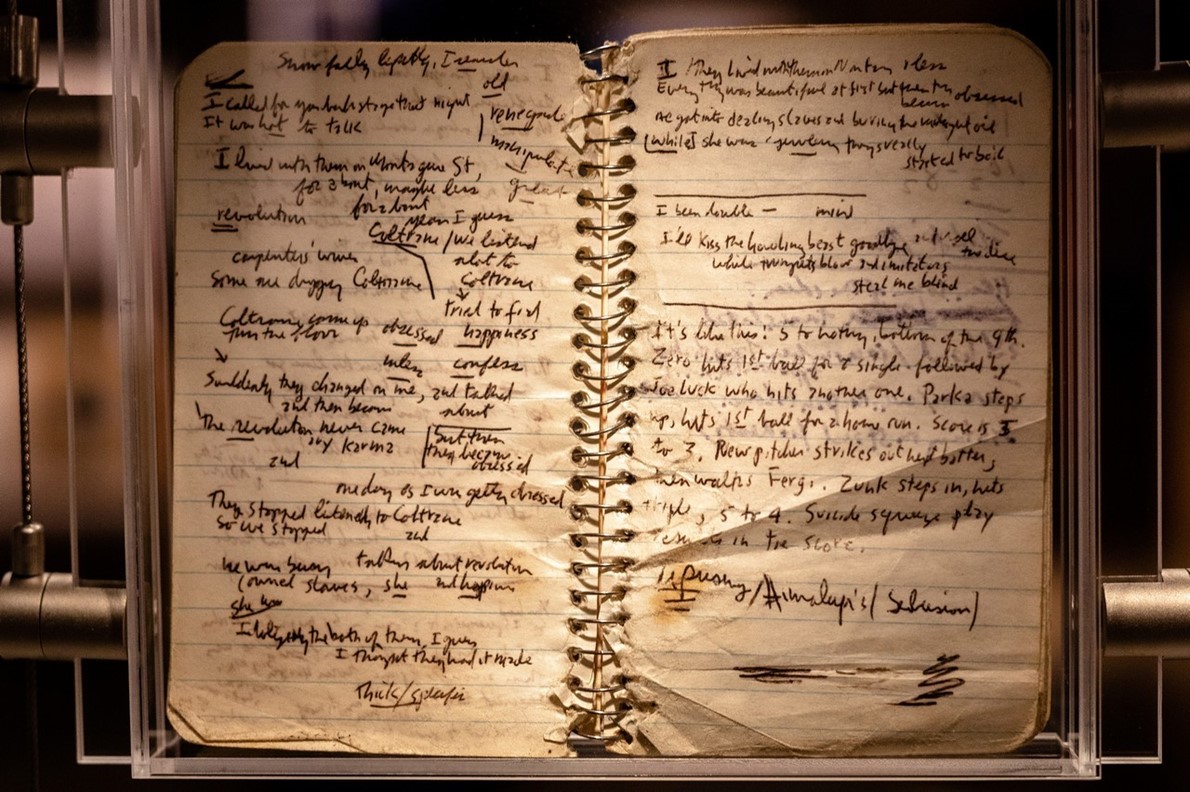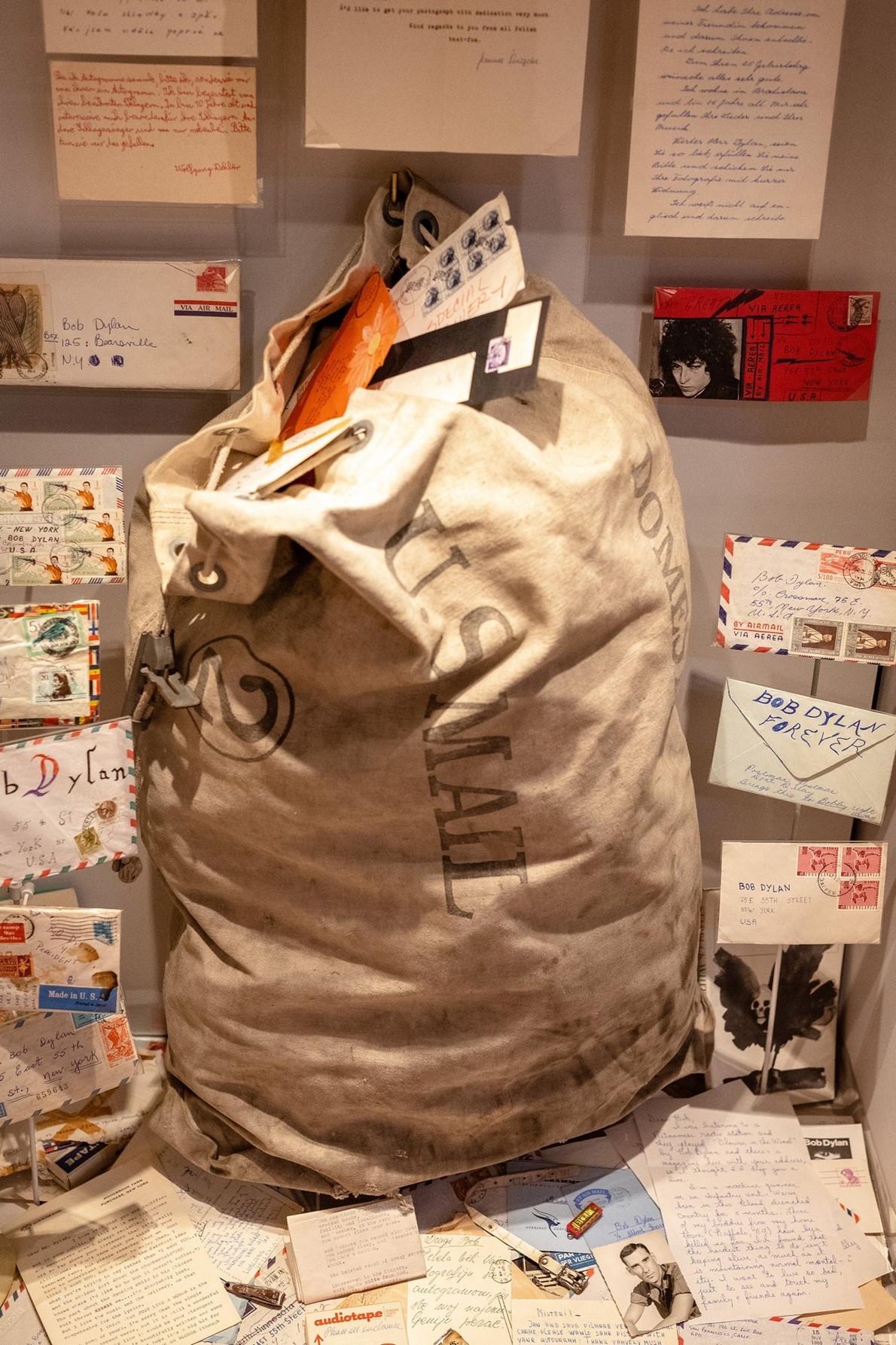Visitors to the new
Bob Dylan Center here
will soon get, at the tap of a finger, what generations of the most avid
Dylanologists have only dreamed of: a step-by-step, word-by-word map of how
Dylan wrote a song.
اضافة اعلان
In a room filled with artifacts a digital display
lets visitors sift through 10 of the 17 known drafts of Dylan’s cryptic 1983 song
“Jokerman”. The screen highlights typed and handwritten changes Dylan made
throughout the manuscripts, showing, for example, how the line “You a son of
the angels/You a man of the clouds” in the song’s earliest iteration was
tweaked, little by little, to end up as “You’re a man of the mountains, you can
walk on the clouds”.
 One of three notebooks containing original handwritten lyrics used on the Bob Dylan album ‘Blood on the Tracks’ on display at the Bob Dylan Center in Tulsa, Oklahoma., April 30, 2022.
One of three notebooks containing original handwritten lyrics used on the Bob Dylan album ‘Blood on the Tracks’ on display at the Bob Dylan Center in Tulsa, Oklahoma., April 30, 2022.
The “Jokerman” exhibit is one instance of how the
organizers of the $10 million Dylan Center — which opens Tuesday, after a long
weekend of inaugural events featuring Elvis Costello, Patti Smith and Mavis
Staples — have tried to bring Dylan’s paper-heavy archives to life and entice
newcomers and experts alike.
It also points to the center’s larger aim of using
Dylan’s vast archive, with documents and artifacts from nearly his entire career,
to illuminate the creative process itself. In addition to exhibits focused on
Dylan’s work, the two-floor, 29,000-square-foot facility will have a rotating
gallery featuring the work of other creators. First up is Jerry Schatzberg, the
filmmaker and photographer who shot the cover of Dylan’s 1966 album “Blonde on
Blonde”.
“We’re really hoping that visitors walk away with a
sense that they can tap into their own creative instincts, their own impulse
for artistic expression, in whatever medium that might be,” Steven Jenkins, the
center’s director, said on a recent tour.
The Dylan Center, located at one end of a
century-old brick industrial building in downtown Tulsa — the Woody Guthrie
Center, devoted to Dylan’s early hero, is at the other — is the museum-like
space founded to display items from the Bob Dylan Archive, which was acquired
in 2016 by the
George Kaiser Family Foundation and the University of Tulsa for
around $20 million. (The Kaiser foundation later bought out the university’s
share.)
The full archive, with about 100,000 items, is
available only to credentialed researchers. It includes huge amounts of
paperwork as well as films, recordings, photographs, books, musical instruments
and curiosities like matchbooks on which Dylan scrawled a few words. (For fire
safety reasons, the matchbooks are kept elsewhere.) Among the many highlights:
a newly discovered film soundtrack from 1961 and four typewritten drafts of
“Tarantula”, the book of disjointed prose poetry that Dylan wrote in the
mid-60s.
In characteristic fashion, Dylan — fully active at
80, with a tour on the road and a new book coming out in the fall — has
stubbornly avoided engaging with attempts to examine his own work, and had no
involvement in the center that bears his name, aside from contributing one of
his ironwork gates for the entryway. (His business office in
New York, however,
has been closely involved.) When he performed in Tulsa last month, at a theater
just a few blocks away, the Nobel laureate made no acknowledgment of the institution
in his honor about to open just down the street.
The challenge for
the Dylan Center is to make the archive understandable to lay audiences while
also drawing on its depths to please the fussiest Dylan experts — the types who
may be well-versed on minutiae like the murky provenance of the red spiral
notebook Dylan used for “Blood on the Tracks,” which is at the Morgan Library
& Museum in New York.
One step was to not
call the new facility a museum at all, but rather a “center” that would
encourage debate and welcome multiple perspectives.
 A bag of fan mail directed to Bob Dylan in 1966, on display at the Bob Dylan Center in Tulsa, Oklahoma., April 30, 2022.
A bag of fan mail directed to Bob Dylan in 1966, on display at the Bob Dylan Center in Tulsa, Oklahoma., April 30, 2022.
“I’m more
interested in this as a living archive than as a museum,” said Alan Maskin of
Olson Kundig, the architecture and design firm behind the Dylan Center. “Museum
implies a voice that everyone accepts as truth.”
Some items, like a
duffel bag of fan mail from 1966, deliver an immediate emotional impact. In
letters from the beginning of the year, fans plead for photos and autographs as
if Dylan were any pop idol. Get-well cards poured in after his motorcycle accident
that July. A November letter from a soldier in Vietnam describes a young man
hearing “Blowin’ in the Wind” on the radio while mourning three fallen friends
in a “blood drenched country”.
Yet Dylan never
read this correspondence. According to Mark A. Davidson, the curator of the
Dylan Archive, the bag had apparently sat untouched for years, and when
archivists received it, none of the mail had been opened.
The center, and the
archive, are already evolving. Exhibits like the jukebox will rotate among
guest curators. And the Dylan Archive has been steadily expanding. In 2016, it
purchased the original tambourine of Bruce Langhorne, who inspired Dylan’s song
“Mr. Tambourine Man”. More recently it has acquired extensive collections from
Mitch Blank in New York and Bill Pagel, who owns two of Dylan’s childhood homes
in Minnesota, as well as books and LPs from Harry Smith, the filmmaker and
polymath known for compiling the seminal “Anthology of American Folk Music”
(1952).
But market values
for
music archives have soared, in part as a result of Dylan’s own deal.
Davidson said that many well-known musicians have offered to sell their
collections, saying: “We want Bob Dylan money.” Jenkins, the center’s director,
said that while the Kaiser foundation covered about half of its $10 million
opening cost — the rest was raised from donors — the institution will seek to
establish enough revenue sources to become financially “self-sustaining”.
Read more Culture and Arts
Jordan News








